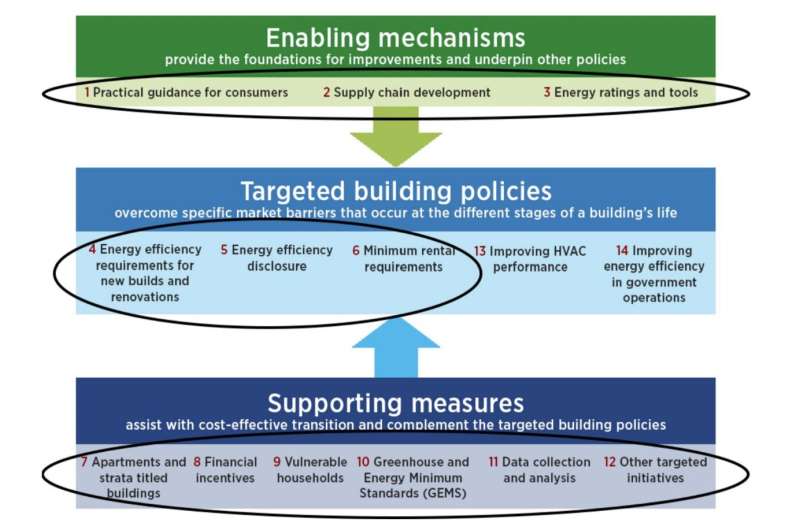This article has been reviewed according to Science X's editorial process and policies. Editors have highlighted the following attributes while ensuring the content's credibility:
fact-checked
trusted source
proofread
Australia won't meet net zero goals without a national approach to home thermal efficiency: Report

An RMIT University-led report, commissioned by RACE for 2030, assessed current challenges related to home thermal efficiency improvements.
The thermal efficiency or performance of a building refers to how well a dwelling can be both energy efficient and comfortable for occupants during different seasons.
The report recommends several priorities to help Australia reach its goal of net zero by 2050, such as improving how we build new homes and how households prioritize and undertake thermal upgrading of their homes.
It also recommends making home energy assessment information widely available and focusing on new research to inform and accelerate progress.
Lead researcher and Inaugural Director of RMIT's new Post-Carbon Infrastructure and Built Environment Research Centre, Professor Priya Rajagopalan, said the thermal performance of a home is often overlooked, with factors such as cost, design, location and convenience considered more pressing to buyers and builders than its thermal performance.
"A thermally efficient home is also an energy efficient one given that heating and cooling represents up to 50% of energy used," said Rajagopalan, who is also Associate Dean of RMIT's School of Property, Construction and Project Management.
"A poorly constructed building shell uses more energy to keep people warm or cool, which leads to an increase in carbon emissions and expensive power bills."
A 2022 study by Sustainability Victoria also indicated thermally comfortable homes can lead to better health outcomes for occupants.
Changing how we build new homes
While the introduction of the new seven-star energy efficiency building standards is a necessary step to improve new homes, Rajagopalan said more needs to be done during the design and construction stage of building to ensure each home is thermally efficient.
She said involving thermal assessors early in the design process would make a difference as they are usually brought in at the end of design process, which is often too late to make cost-effective improvements.
"Designers rely on energy rating tools to help them make sure the designs are thermally efficient and meet minimum standards, but often what is designed in the software doesn't translate fully in the real setting. Improved training of all trades, highlighting the consequences of poor construction practices, is essential to make sure they are delivering as per the specifications," she said.
"There might also be unexpected air leakage or moisture entry in the physical build that the software is unable to predict."
"So not only do we need to make assumptions in rating tools as close to reality and involve thermal assessors earlier in the design phase so they can point out issues before it is too late, but we also need to ensure that what is designed is then actually built."
Rajagopalan said while high-performance windows and insulation were essential to the thermal efficiency of a building, cost remained a barrier for some.
"High-performance windows could cost you more upfront to install, but eventually, it could save you thousands on energy bills and improve thermal comfort" she said.
Rajagopalan said messaging needed to focus on the range of benefits—including better health, well-being and quality of life—instead of just focusing on upfront costs and short-term payback savings.
Retrofitting existing homes
Australia has 10 million existing homes, most of which have poor energy and thermal performance.
Rajagopalan said government assistance was urgently needed in designing and rolling out an affordable thermal performance assessment program necessary to start the retrofitting process of existing homes.
"You can buy more energy efficient lights and appliances for your home, but it's trickier and more expensive to retrofit a home to be more thermally efficient," she said.
Rajagopalan said there was already a lot of information about retrofitting homes, but the reliability and accuracy of the information varied.
A potential solution was creating a "one-stop shop" on how to embark on retrofitting your home and the benefits of a thermally efficient home from verified sources.
"This will help manage home energy upgrades from start to finish and offer a smooth customer journey to ensure better outcomes," she said.
Policy changes needed to help renters
Rajagopalan said Australian renters are at a disadvantage as they have little control over the thermal or energy efficiency of rental properties.
"Even with government subsidies for retrofitting rental properties to improve thermal or energy efficiency, these don't necessarily translate into action by landlords, or deter them from increasing rents after upgrades," she said.
In August last year, France introduced a climate and resilience law preventing landlords from increasing the cost of rent on properties with poor energy efficiency ratings (ranked F or G).
From January 2023, it has been illegal to rent the absolute least energy efficient properties in France.
More recently in Australia, Victoria introduced basic standards for rental homes that included window coverings, adequate ventilation and energy efficient heaters.
In the ACT, all rental homes were required to have at least R5 insulation in ceilings, which can help a home retain heat in winter and reduce heat entering in summer.
Rajagopalan said she would like to see higher standards across the country to help ensure all renters lived in thermally comfortable and energy efficient homes.
"Effective policies that improve the thermal performance of over three million rental accommodations across Australia can contribute to easing the deepening housing crisis and help towards improving the quality of life of residents, majority of which are lower income population," she said
"We need to make sure the public know thermally efficient homes have significant health, well-being and social benefits, as they are not talked about enough."
"It might even put some pressure on designers, builders and policy makers to build better performing homes and roll out retrofit program for homeowners and renters."
More information: Report: racefor2030.com.au/wp-content/ … 99-Final-Report_.pdf

















